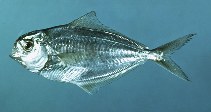Peprilus triacanthus (Peck, 1804)
Atlantic butterfish
Uploaden van uw Foto's en video's
Pictures | Google afbeeldingPeprilus triacanthus
Picture by Flescher, D.
Pictures | Google afbeeldingPeprilus triacanthus
Picture by Flescher, D.
Common names from other countries
Classificatie / Names Lokale namen | Synoniemen | Catalog of Fishes(Genus, Soort(en)) | ITIS | CoL | WoRMS | Cloffa
> Scombriformes (Mackerels) > Stromateidae (Butterfishes)
Etymology: Peprilus: Greek, peprilos, paprax, certain fish from Tracia.
Etymology: Peprilus: Greek, peprilos, paprax, certain fish from Tracia.
Environment: milieu / climate zone / depth range / distribution range Ecologie
marien; brak water benthopelagisch; oceanodroom (Ref. 51243); diepte 15 - 420 m (Ref. 58426), usually ? - 55 m (Ref. 53006). Subtropical; 62°N - 26°N, 87°W - 52°W
Verspreiding Landen | FAO regio's | Ecosystemen | Voorkomen | Point map | Introducties | Faunafri
Western Atlantic: from Labrador (Ref. 58426) to the gulf coasts of Florida (Ref. 2702). Absent in Bermuda or Caribbean (Ref. 26938).
Lengte bij maturiteit / Grootte / Gewicht / Leeftijd
Maturity: Lm 12.0 range ? - ? cm
Max length : 30.0 cm TL mannelijk / geslacht onbekend; (Ref. 7251); common length : 20.0 cm TL mannelijk / geslacht onbekend; (Ref. 2702)
Max length : 30.0 cm TL mannelijk / geslacht onbekend; (Ref. 7251); common length : 20.0 cm TL mannelijk / geslacht onbekend; (Ref. 2702)
Korte beschrijving Determinatiesleutels | Morfologie | Morfometrie
Dorsale stekels (totaal) : 3; Anale stekels: 3. This species is distinguished by the following characters: body oval to somewhat elongate, moderately deep (its depth 2.7 to 3 times in total length) and strongly compressed; eye medium-sized (its diameter 3.4 to 3.7 times in head length), surrounded by a small area of adipose tissue; snout short and blunt, lower jaw projecting somewhat beyond upper; mouth small, tip of maxillary not reaching to anterior eye margin; teeth in jaws very small, in a single row, while those in the upper jaw flattened and with 3 tiny cusps; dorsal and anal-fin bases very long (about equal in length), the anterior fin rays elevated, but fins not falcate, and both fins preceded by 3 short, weak, spines; caudal fin deeply forked; pectoral fins long (longer than head) and pointed; pelvic fins absent; a conspicuous series of 17 to 25 pores along anterior half of body under dorsal fin; lateral line high, following dorsal profile; scales small, present also on cheeks; caudal vertebrae 17 to 20; body color pale blue above, silvery below; numerous irregular dark spots on sides in live fish (fading after death) (Ref. 53006).
Forms large schools over the continental shelf, except during the winter months when it may descend to deeper water. Juveniles are generally found under floating weeds and jellyfish. Often found in brackish waters (Ref. 26938). Nerito-pelagic (Ref. 58426). Adults feeds mainly on jellyfish (Ref. 26938), squids, arrow worms, crustaceans and worms (Ref. 58426). Marketed fresh, smoked and frozen; eaten fried, broiled and baked (Ref. 9988). Mostly frozen and exported to Japan.
Levenscyclus en paargedrag Maturiteit | Voortplanting | Paaien | Eieren | Fecunditeit | Larven
Hoofdreferentie
Upload your references | Referenties | Coördinator | Medewerkers
Robins, C.R. and G.C. Ray, 1986. A field guide to Atlantic coast fishes of North America. Houghton Mifflin Company, Boston, U.S.A. 354 p. (Ref. 7251)
Gevaar voor de mens
Harmless
Gebruik door de mens
Visserij: commercieel; sportvis: ja
FAO(visserij: productie; publication : search) | FishSource | Sea Around Us
Meer informatie
Population dynamics
Groeiparameters
Max. ages / sizes
Length-weight rel.
Length-length rel.
Lengtefrequenties
Massaconversie
Rekrutering
Abundantie
Groeiparameters
Max. ages / sizes
Length-weight rel.
Length-length rel.
Lengtefrequenties
Massaconversie
Rekrutering
Abundantie
Life cycle
Voortplanting
Maturiteit
Fecunditeit
Paaien
Spawning aggregations
Eieren
Ontwikkeling van de eieren
Larven
Larvale populatiedynamiek
Voortplanting
Maturiteit
Fecunditeit
Paaien
Spawning aggregations
Eieren
Ontwikkeling van de eieren
Larven
Larvale populatiedynamiek
Physiology
Body composition
Nutrients
Zuurstofverbruik
Zwemtype
Zwemsnelheid
Visual pigments
Fish sound
Diseases & Parasites
Toxicity (LC50s)
Body composition
Nutrients
Zuurstofverbruik
Zwemtype
Zwemsnelheid
Visual pigments
Fish sound
Diseases & Parasites
Toxicity (LC50s)
Human related
Aquaculture systems
Aquacultuurprofielen
Kweeklijnen
Ciguatera cases
Stamps, coins, misc.
Aquaculture systems
Aquacultuurprofielen
Kweeklijnen
Ciguatera cases
Stamps, coins, misc.
Tools
E-boek | Veldgids | Determinatiesleutels | Lengtefrequentie Tool | Levenscyclus tool | Verspreidingskaart | Classification Tree
| Catch-MSY |
Speciale rapporten
Bekijk gegevens voor het houden in een aquarium | Bekijk Fact Sheets voor de soort | Bekijk Aquacultuur Fact Sheets
Download XML
Internetbronnen
Aquatic Commons | BHL | Cloffa | Websites from users | Bekijk FishWatcher | CISTI | Catalog of Fishes(Genus, Soort(en)) | DiscoverLife | ECOTOX | Faunafri | Fishtrace | GenBank(genoom, nucleotide) | GloBI | GOBASE | | Google Books | Google Scholar | Google | IGFA World Record | MitoFish | Otolith Atlas of Taiwan Fishes | PubMed | Reef Life Survey | Scirus | SeaLifeBase | Tree of Life | Wikipedia(ga naar, zoek) | World Records Freshwater Fishing | Zoological Record
Estimates based on models
Preferred temperature (Ref. 115969): 5.1 - 24.7, mean 21.7 (based on 250 cells).
Fylogenetische diversiteitsindex (Ref. 82804): PD50 = 0.5020 [Uniqueness, from 0.5 = low to 2.0 = high].
Bayesian length-weight: a=0.01230 (0.00867 - 0.01745), b=3.14 (3.04 - 3.24), in cm Total Length, based on LWR estimates for this species (Ref. 93245).
Trofisch niveau (Ref. 69278): 3.9 ±0.0 se; based on diet studies.
Weerstandsvermogen (Ref. 120179): Hoog, minimale populatieverdubbelingstijd minder dan 15 maanden (K=0.8(?); tm=1).
Fishing Vulnerability (Ref. 59153): Low vulnerability (20 of 100).
Climate Vulnerability (Ref. 125649): Low vulnerability (22 of 100).




